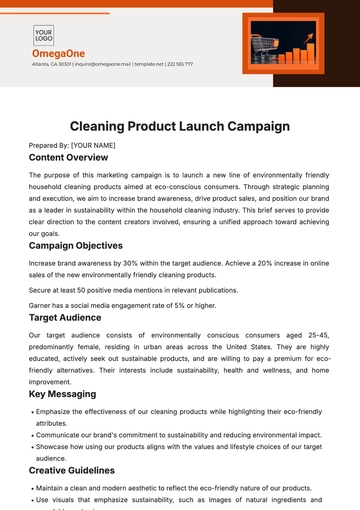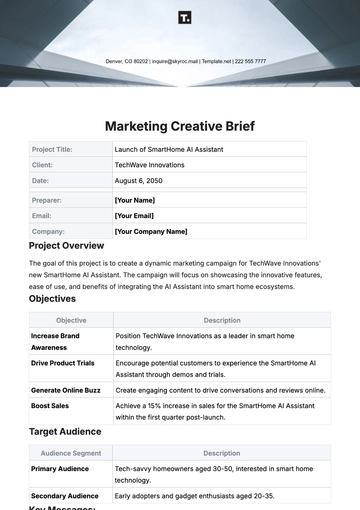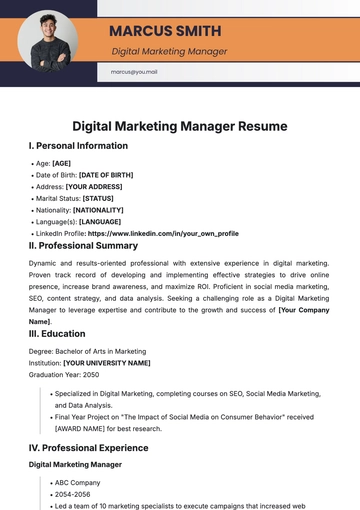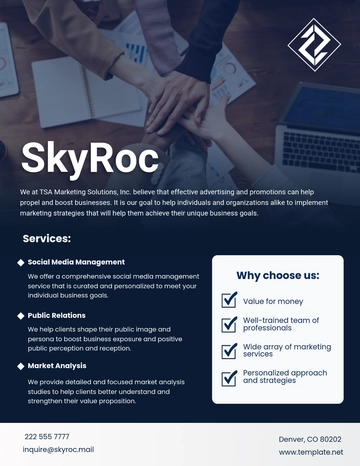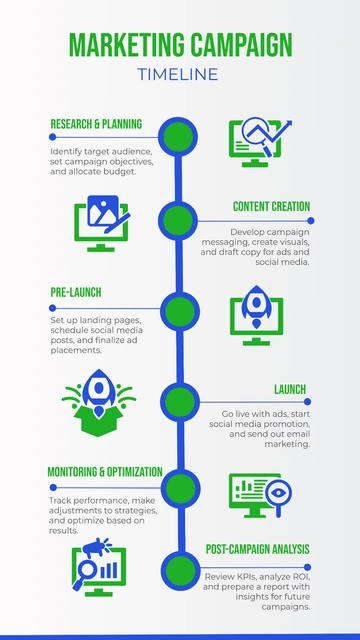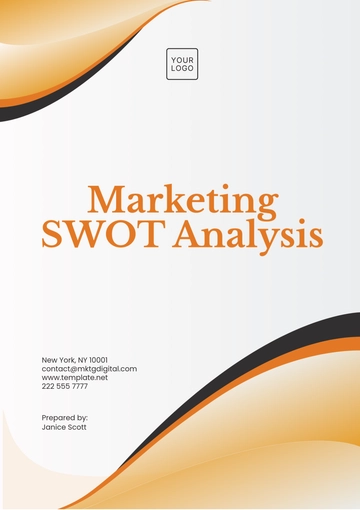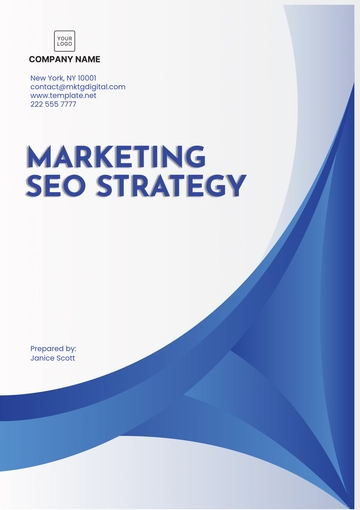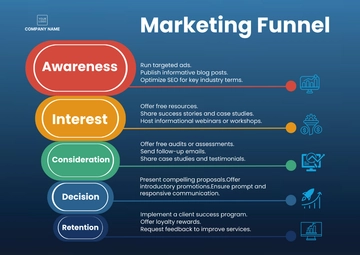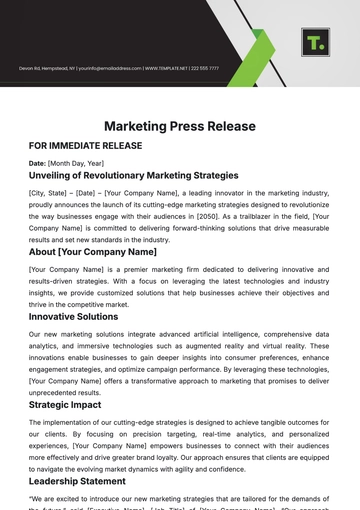Free Marketing Global Market Case Study

[Your Company Name]'s Expansion Into The Asian Market
I. Company Overview
[Your Company Name] is a visionary and globally recognized technology conglomerate, headquartered in [Your Company Address]. With an illustrious legacy spanning over three decades, the company has consistently pushed the boundaries of innovation in consumer electronics. [Your Company Name]'s diverse product portfolio encompasses state-of-the-art smartphones, tablets, smart home devices, and cutting-edge IoT solutions.
Renowned for its unwavering commitment to excellence, [Your Company Name] has become a household name in [Country], setting industry benchmarks in quality, design, and technological innovation. The company's legacy of transformative products, such as the [Your Company's Product/Service], has earned it numerous accolades and a fiercely loyal global customer base.
Fuelled by a pioneering spirit and an unquenchable thirst for innovation, [Your Company Name] has embarked on an ambitious journey to extend its influence and reach into the dynamic and rapidly evolving Asian market, a region teeming with immense potential and possibilities. This case study delves into [Your Company Name]'s strategic endeavors and remarkable successes in its quest to conquer the Asian technology landscape.
II. Market Analysis
The Asian technology market was a strategic choice for [Your Company Name] due to its immense potential. With a population exceeding 4.6 billion people and a rapidly growing middle class, Asia presented a tantalizingly lucrative opportunity for the company. The region was not only home to a diverse array of consumer preferences but also characterized by a dynamic and ever-evolving technological landscape.
Key Market Segments:
India - The Emerging Giant | India, with its youthful population and increasing digital adoption, was a focal point for [Your Company Name]'s expansion. The smartphone penetration rate was soaring, and the Indian market showed a voracious appetite for affordable yet feature-rich devices. [Your Company Name] aimed to tap into this vast market by offering competitively priced smartphones tailored to Indian tastes. |
China - The Tech Powerhouse | As the world's largest smartphone market, China presented both immense opportunities and fierce competition. [Your Company Name] recognized the importance of innovation and quality in this highly saturated market and invested heavily in research and development to meet the discerning Chinese consumer's demands. |
Japan - A Hub For Innovation | Japan, renowned for its tech-savvy population, provided an avenue for [Your Company Name] to showcase its cutting-edge technology and premium devices. The company positioned itself as a provider of high-end gadgets that catered to Japan's affinity for innovation and craftsmanship. |
South Korea - A Playground For Tech Enthusiasts | South Korea's tech-savvy population offered a unique challenge and opportunity. [Your Company Name] engaged in partnerships with local influencers and gaming companies to gain traction in this market. Its products were marketed as the ultimate choice for mobile gaming and entertainment. |
Market Trends And Dynamics:
In addition to understanding the demographics and preferences of each market segment, [Your Company Name] closely monitored regional market trends and dynamics. This included tracking the rise of 5G technology, the increasing demand for eco-friendly devices, and the impact of the COVID-19 pandemic on consumer behavior. The company adapted its product development and marketing strategies in real-time to align with these evolving trends.
Competitive Landscape:
The competitive landscape in the Asian tech market was fierce, featuring a mix of established local giants and global tech leaders. [Your Company Name] analyzed its competitors' strategies, pricing models, and product offerings to position itself effectively. Leveraging its agility and a focus on customer-centricity, [Your Company Name] aimed to carve out a distinctive niche in each of its target markets.
Market Entry Strategy:
With a comprehensive understanding of the Asian market, [Your Company Name] devised a phased market entry strategy that accounted for the unique characteristics of each country. This approach allowed the company to leverage its strengths while adapting to local conditions and preferences, contributing to its overall success in the region.
III. Marketing Strategy
[Your Company Name]'s marketing strategy for penetrating the Asian market was meticulously designed to address the unique challenges and opportunities presented by the region. The company executed a multi-faceted approach that resonated with the diverse consumer base in Asia:
Product Localization | Understanding that one size does not fit all, [Your Company Name] embarked on an extensive product localization effort. This involved tailoring their devices to cater to the specific needs and preferences of each Asian market. For instance, in India, the company introduced smartphones with extended battery life to accommodate frequent power outages, while in Japan, they focused on integrating advanced camera technology to align with the local enthusiasm for photography. |
In-Depth Market Research | [Your Company Name] invested significantly in comprehensive market research, working closely with local research agencies to decode consumer behavior, preferences, and cultural nuances. This data-driven approach allowed the company to fine-tune product development, pricing strategies, and marketing campaigns to align perfectly with the Asian audience's desires. |
Strategic Partnerships | Recognizing the complexity of distribution networks and the importance of local expertise, [Your Company Name] forged strategic partnerships with well-established Asian retailers and e-commerce giants. These partnerships not only ensured wide product availability but also provided valuable insights into local market dynamics and trends. |
Promotional Campaigns With Local Flair | To build brand recognition and trust, [Your Company Name] launched region-specific promotional campaigns that featured prominent local celebrities and influencers. These influencers not only lent credibility but also helped bridge cultural gaps, making the brand feel more relatable and approachable to the target audience. The campaigns were meticulously crafted to resonate with local sensibilities, leveraging storytelling that tapped into cultural narratives and values. |
Omnichannel Approach | Recognizing the importance of both online and offline channels in Asian markets, [Your Company Name] adopted an omnichannel approach. The company ensured a seamless customer experience, from online research and purchase to in-store support and service centers. This approach not only boosted sales but also enhanced customer satisfaction and loyalty. |
Social Responsibility Initiatives | [Your Company Name] also made a conscious effort to engage in socially responsible initiatives in the communities where it operated. This included environmental sustainability efforts, partnerships with local NGOs, and technology education programs, which not only contributed to the company's positive image but also resonated with the socially conscious Asian consumers. |
IV. Challenges And Obstacles
While [Your Company Name]'s expansion into the Asian market was ultimately successful, it was not without its share of formidable challenges and obstacles that required strategic adaptation and innovation:
Regulatory Hurdles | Navigating the complex and diverse regulatory landscapes across Asian countries proved to be a formidable challenge. Compliance with local laws, certifications, and import/export regulations necessitated a dedicated legal and compliance team to ensure [Your Company Name]'s products met all necessary requirements while minimizing regulatory risks. |
Intense Competition And Price Sensitivity | The Asian tech market was not only highly competitive but also exceptionally price-sensitive. Competing against both well-established local giants and international competitors meant that pricing strategies had to be finely tuned to maintain profitability while remaining competitive. |
Cultural Adaptation And Communication | Ensuring that the marketing message resonated with diverse cultural backgrounds and values was an ongoing and intricate challenge. [Your Company Name] invested heavily in culturally sensitive advertising and messaging, avoiding missteps that could have led to reputational damage in such a dynamic and culturally rich region. |
Supply Chain Complexities | Coordinating the supply chain across different countries with varying infrastructures and logistics capabilities was a logistical challenge. [Your Company Name] had to optimize its supply chain operations to ensure efficient delivery of products to meet the demands of an expanding customer base. |
Consumer Trust Building | Establishing trust with consumers in a new market was a continuous effort. [Your Company Name] undertook initiatives to engage with local communities, offer exceptional customer service, and provide robust warranties and after-sales support to build and maintain a strong reputation in the region. |
Economic Volatility | Fluctuations in currency exchange rates and economic volatility in certain Asian markets required the company to implement financial risk management strategies to protect its bottom line and ensure stable pricing for consumers. |
Technological Adaptation | Adapting [Your Company Name]'s product portfolio to the diverse technological preferences and standards in Asia was a multifaceted challenge. From network compatibility to software localization, ensuring seamless integration with local tech ecosystems was imperative. |
Human Resource Management | Managing a culturally diverse and geographically dispersed workforce posed its own set of challenges. [Your Company Name] invested in cross-cultural training and team-building initiatives to foster a collaborative and innovative work environment. |
V. Success Stories
Despite the formidable challenges [Your Company Name] faced during its expansion into the Asian market, the company achieved remarkable success, making a significant impact in a relatively short period:
Market Share Surge | Within just three years of venturing into the Asian market, [Your Company Name] experienced an impressive ascent in market share. The company secured an astonishing 15% share of the fiercely competitive smartphone market in India, effectively positioning itself as a major player in the region. Furthermore, it recorded double-digit growth rates in China and South Korea, solidifying its presence in these pivotal markets. |
Revenue Soars | [Your Company Name]'s strategic move into Asia yielded substantial financial rewards. The company reported a remarkable 20% increase in its global revenue, with the Asian market contributing a substantial 35% share. This marked a substantial jump from a mere 10% before the expansion. This substantial revenue increase was a testament to [Your Company Name]'s astute understanding of the region's dynamics and the effective execution of its market entry strategy. |
Elevated Brand Reputation | The company's careful attention to localization and cultural sensitivities paid off handsomely. [Your Company Name] managed to elevate its brand image in Asia, effectively shedding its image as a foreign tech giant and becoming a brand that resonated with Asian consumers. This newfound reputation for customer-centricity, product innovation, and cultural empathy played a pivotal role in its regional success. |
Influential Marketing Campaigns | [Your Company Name]'s regional marketing campaigns featuring popular local celebrities and influencers garnered widespread attention and praise. These campaigns not only helped the brand connect with its target audience but also generated significant buzz in the Asian tech landscape. These campaigns became industry benchmarks, often cited for their ingenuity and effectiveness. |
Community Engagement | The company made strides in fostering community engagement and corporate responsibility initiatives across the Asian markets. [Your Company Name]'s contributions to education, technology accessibility, and environmental sustainability initiatives were well-received and underscored its commitment to the well-being of the communities it operated in. |
VI. Lessons Learned
The key takeaways from [Your Company Name]'s expansion into the Asian market are:
Localization Is Essential | Adapting products and marketing strategies to cater to local preferences and cultural nuances is paramount for success in diverse markets. |
Strategic Partnerships Matter | Establishing and nurturing partnerships with local distributors and retailers streamlines market entry and strengthens distribution channels. |
Regulatory Mastery Is Crucial | A thorough understanding of local regulations and compliance requirements is fundamental for navigating complex markets effectively. |
VII. Conclusion
In this Marketing Global Market Case Study, we examined [Your Company Name]'s successful expansion into the highly competitive Asian technology market. The company's strategic approach, which included product localization, extensive market research, strategic partnerships, and region-specific promotional campaigns, allowed it to navigate the challenges and capitalize on the opportunities presented by the diverse Asian markets.
[Your Company Name]'s dedication to understanding local consumer preferences and regulatory landscapes, coupled with its commitment to cultural adaptation, led to remarkable achievements. Notably, the company experienced substantial market share growth, revenue increases, and a positive brand image in the region within a relatively short period.
In conclusion, [Your Company Name]'s journey into the Asian market serves as a valuable case study for businesses aiming to expand globally. It highlights the significance of strategic planning, localization, and adaptability in achieving success in diverse and competitive markets. By adhering to the lessons learned and implementing the recommended strategies, [Your Company Name] is well-positioned to sustain and further enhance its presence in the dynamic Asian technology landscape.
- 100% Customizable, free editor
- Access 1 Million+ Templates, photo’s & graphics
- Download or share as a template
- Click and replace photos, graphics, text, backgrounds
- Resize, crop, AI write & more
- Access advanced editor
Introducing the Marketing Global Market Case Study Template, exclusively from Template.net! Dive into market insights with ease using this editable and customizable tool. Crafted for precision, it's editable in our AI Editor Tool, empowering tailored analysis. Explore global trends and elevate your marketing strategies effortlessly. Enhance your case studies with this essential template.
You may also like
- Marketing Google Slide
- Marketing Letter
- Marketing Quotation
- Marketing Report
- Marketing Strategic Plan
- Marketing Plan
- Marketing Proposal
- Marketing Flyer
- Marketing Presentation
- Real Estate Marketing Plan
- Marketing Contract
- Marketing Agreement
- Marketing Resume
- Marketing Checklist
- Marketing Brochure
- Marketing Banner
- Marketing Schedule
- Marketing Vector
- Marketing Logo
- Marketing Chart
- Marketing Campaign Plan
- Marketing Budget
- Marketing Postcard
- Marketing Poster
- Marketing Facebook Post
- Marketing Instagram Post
- Marketing Newsletter
- Marketing Infographic




